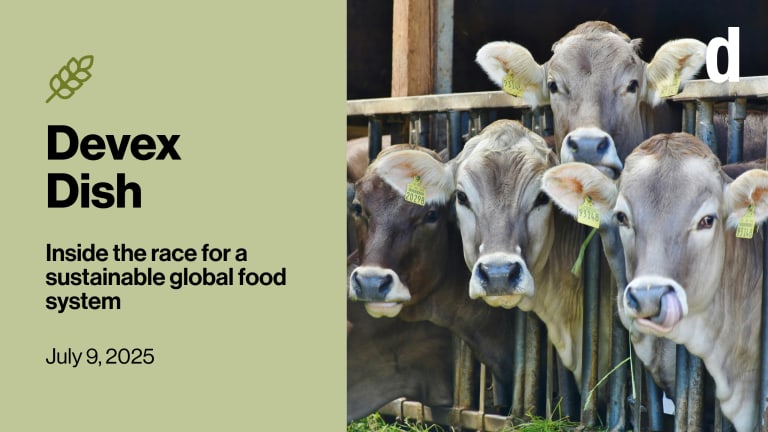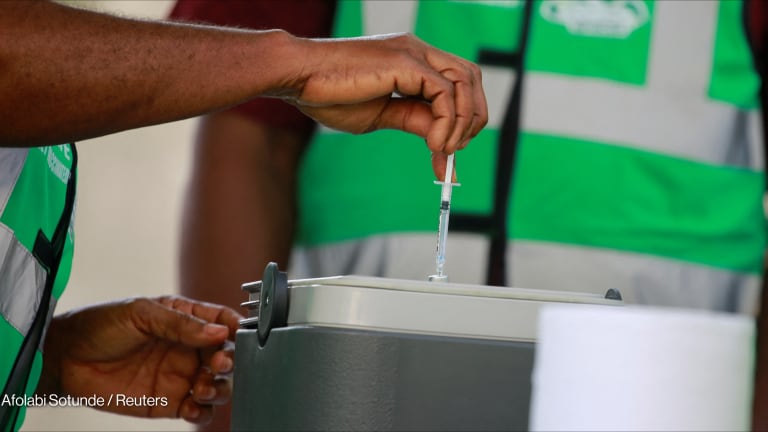Q&A: What it will take to prevent another virus 'spillover'
What's better than containing a disease outbreak? Preventing it in the first place. Devex speaks to Dr. Aaron Bernstein, chair of the Scientific Task Force to Prevent Pandemics at the Source, about a new report on how to do that.
There’s a new report providing recommendations on how to prevent the next pandemic. But unlike others, this one focuses on preventing the spillover of virus pathogens from animals to humans — and the investments needed to make that happen. The report, published by the Harvard-led International Scientific Task Force to Prevent Pandemics at the Source, identifies potential sources of viruses that could infect humans. Bats, for instance, are known “reservoirs” for a number of viral human diseases, such as coronaviruses e.g., SARS, and filoviruses e.g., Ebola. It also tackles the question of where the next pandemic may emerge and the different modeling approaches being used to predict that — which can sometimes produce very different answers. Devex spoke to Dr. Aaron Bernstein, chair of the Scientific Task Force, about the report, the investments needed to stop viruses spilling over from animals to humans — and what happens if governments fail to deliver those investments. This conversation has been edited for length and clarity. How different are your recommendations on preventing the next pandemic from the many other reports that have been published during the past year? Almost all other reports focus on taking actions that contain disease outbreaks after they start but do not address the root causes of pandemics. For instance, The G-20 High Level Panel or the Independent Panel on Pandemic Preparedness suggest measures that try to contain outbreaks after they happen, primarily through vaccines, testing, and health care system strengthening. These are all important but do not address what an abundance of scientific research identifies as the source of pandemic risk: The spillover of pathogens from wildlife to people. Preventing even one pandemic of COVID-19’s magnitude, which has drained $4 trillion for global GDP, will afford savings that will justify the investments --— Dr. Aaron Bernstein, chair, International Scientific Task Force to Prevent Pandemics at the Source Containment measures also are likely to promote inequity. Drugs and vaccines benefit wealthier people and wealthier countries first as COVID-19 has made abundantly clear. That means that sole reliance on containment strategies risks rolling back progress on development goals. In contrast, our report finds that the overwhelming majority of science points to preventing spillover as the mainstay of pandemic prevention. While true that a more interconnected and populous world may promote pandemic risk, we will not prevent pandemics by stopping travel or depopulating cities. We can prevent pandemics by protecting nature and forests in particular. Furthermore, and in sharp contrast to the recommendations of the G-20 High Level Panel and the Independent Panel, the investments this report calls for will have benefits beyond addressing infectious disease risk. Preventing deforestation averts carbon emissions. Addressing spillover in wildlife and livestock can save species and prevent agricultural losses, among many other such ancillary benefits. How much investment will be needed to stop virus spillovers? And would this be on top of the investment proposals coming from the G-20 High Level Panel and the Independent Panel? A paper we published in Science last summer estimated that an investment of $21 billion to $31 billion targeted in infectious disease emergence hotspots could substantially reduce pandemic risk. This is a fraction of the costs associated with COVID-19 alone. The High Level Panel funding could, in part, be incentivized toward spillover prevention, especially those investments that go to health system strengthening. We have models that demonstrate how such investments, when made in communities where conservation interest and spillover risk coincide, can promote the health of the populations served and advance conservation goals. Ultimately, we don’t have a choice but to invest in nature conservation. If we spend the $75 billion that the High Level Panel recommends entirely on containment and don’t address spillover risk, we will have stronger health systems and greater readiness with vaccines and drugs, but we will live on a planet with an ever more destabilized climate and depleted biosphere where spillover may be more likely than it is today, and no amount of vaccines, drugs, or health systems will fix that. Who's going to be funding this? The investments will come from national governments, who will recognize that we must prevent spillover to address pandemic risk and that doing so will afford many other benefits, especially to global development work, climate change, and conservation. The individuals deciding on where funds to address pandemic risk will land must recognize that investing in nature conservation is an investment in human health care. Anticipating limited funding, what would be your top priority investment areas? Forest conservation and biosecurity around farmed animal operations are top priorities for pandemic prevention. Worldwide, the sum total of spending on forest conservation is only $2 billion per year, and spending on biosecurity around animal farms is far less. Yet each of these areas are where spillover risk may be greatest. For comparison, the Biden administration plans to spend $3 billion on drug development for coronaviruses alone. What happens if donors and governments ignore these recommendations? We will have spent tens of billions of dollars and possibly still have to contend with a pandemic as devastating as COVID-19. While we absolutely need vaccines and stronger health systems, as our present circumstances make painfully clear, we cannot inoculate our way out of pandemic risk. Nor can we build health care systems that can withstand the onslaught of diseases like COVID-19. We cannot prevent all spillover, but preventing even one pandemic of COVID-19’s magnitude, which has drained $4 trillion for global GDP, will afford savings that will justify the investments called for in this report.
There’s a new report providing recommendations on how to prevent the next pandemic. But unlike others, this one focuses on preventing the spillover of virus pathogens from animals to humans — and the investments needed to make that happen.
The report, published by the Harvard-led International Scientific Task Force to Prevent Pandemics at the Source, identifies potential sources of viruses that could infect humans. Bats, for instance, are known “reservoirs” for a number of viral human diseases, such as coronaviruses e.g., SARS, and filoviruses e.g., Ebola.
It also tackles the question of where the next pandemic may emerge and the different modeling approaches being used to predict that — which can sometimes produce very different answers.
This story is forDevex Promembers
Unlock this story now with a 15-day free trial of Devex Pro.
With a Devex Pro subscription you'll get access to deeper analysis and exclusive insights from our reporters and analysts.
Start my free trialRequest a group subscription Printing articles to share with others is a breach of our terms and conditions and copyright policy. Please use the sharing options on the left side of the article. Devex Pro members may share up to 10 articles per month using the Pro share tool ( ).
Jenny Lei Ravelo is a Devex Senior Reporter based in Manila. She covers global health, with a particular focus on the World Health Organization, and other development and humanitarian aid trends in Asia Pacific. Prior to Devex, she wrote for ABS-CBN, one of the largest broadcasting networks in the Philippines, and was a copy editor for various international scientific journals. She received her journalism degree from the University of Santo Tomas.








